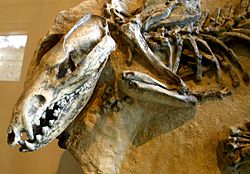Metatheria facts for kids
Quick facts for kids MetatheriaTemporal range: Lower Cretaceous – Holocene, 125 mya to present
|
|
|---|---|
 |
|
| Lycopsis longirostris, an extinct Sparassodont, relatives of the marsupials | |
| Scientific classification | |
| Kingdom: | |
| Phylum: | |
| Class: | |
| Subclass: | |
| Infraclass: |
Metatheria
|
| Orders and infraclasses | |
|
|
Metatheria is a group in the class Mammalia which contains the marsupials and the sparassodonts.
First proposed by Thomas Henry Huxley in 1880, it is nearly synonymous with the earlier taxon Marsupialia, but it also contains the nearest fossil relatives of marsupial mammals. They differ from all other mammals in their dental formula, which includes about five upper and four lower incisors, a canine, three premolars, and four molars.
The earliest known representative, Sinodelphys, is from the Lower Cretaceous of China.
The closest relatives of the metatheres are the Eutheria (also erected by Huxley in 1880). Both are conventionally united as infraclasses within the subclass Theria, which contains all living mammals except monotremes.
During development, metatherians produce a yolk sac placenta and give birth to 'larval-like' offspring.
These offspring have underdeveloped rear limbs, and after birth they migrate to the marsupium where they attach to a nipple. The mouth of newly born metatherians forms an "O" shape into which the mother's nipple fits. Then it swells to secure the offspring into place.
The Greek words meta- and theria roughly means the "other beasts", in contrast with Eutheria ("true beasts").
Evolutionary history
Metatherians first appeared in the Cretaceous period. Some stem group metatherians persisted well into the Neogene period before becoming extinct. Crown group marsupials, the one branch of Metatheria that survives today, diversified close to the time of extinction at the end of the Cretaceous.
See also
 In Spanish: Metatheria para niños
In Spanish: Metatheria para niños

